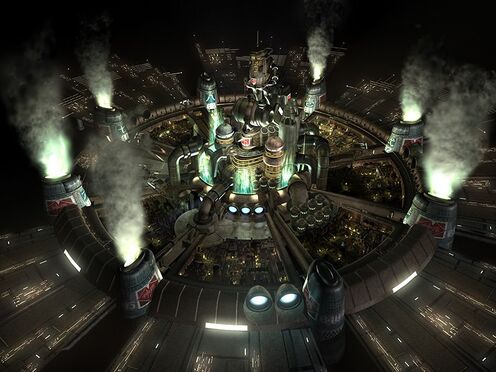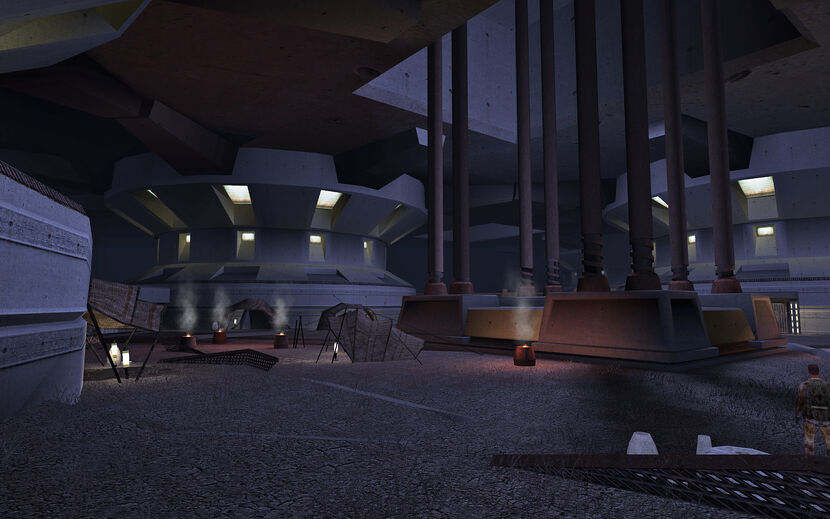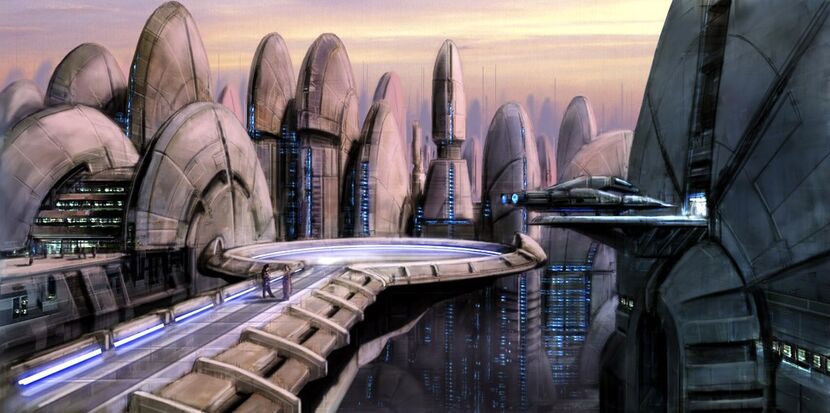I find it interesting when video games take on or replicate this notion of social stratification within their fictional worlds. The first game I remember playing that noticeably emphasized this phenomenon was Final Fantasy VII. The narrative of that sprawling Japanese role-playing game starts off in the metropolis of Midgar—a round, monolithic structure of a city set up and lorded over by the Shinra Electric Power Company.

Essentially a giant power plant with a series of symmetrically placed reactors, the city cradles a divided populace. While a vibrant cityscape thrives atop a series of pillar-supported plates, an immense hive of sun-deprived slums carries on below. Residents in the slums live their lives cut off from and restricted access to the world above, by means of a high-tech security apparatus. Crime flourishes amidst the otherwise lawless underbelly and the people build their shantytown empire on the discarded scraps that trickle down from the world above.
I’ve played other games that employ similar world design. The setting of Deus Ex: Invisible War, for example, begins in a futuristic Seattle, Wash., that—following a global technological collapse and subsequent rebirth—finds itself stratified into upper and lower sections. Upper Seattle is a high-tech enclave populated with wealthy citizens and governed—quite fittingly—by the World Trade Organization (who’s having the last laugh now?). Lower Seattle is a dingy environment in which a criminal black market occupies much of the power vacuum, and travel between the two sectors is restricted along socioeconomic lines.
I bring this all up as a lengthy segue to talk about what I’m currently playing. For about the past week I’ve been slowly getting into a game called Star Wars: Knights of the Old Republic. It’s a game that came out a long, long time ago in 2003 on the original Xbox and PC. It’s also a game that’s been in my backlog collection for quite a while, and this essentially is my first time through.
As one can probably imagine, the Star Wars franchise had already seen its fair share of video game adaptations when KOTOR (as it’s commonly acronymed) first released, some better received than others. This game immediately stood out from the crowd for being a Star Wars-themed role-playing game (RPG) developed by BioWare, a company that had a reputation for creating great RPGs.
The story in KOTOR takes place 4,000 years before the George Lucas films. There is war in the galaxy. The Republic and its noble Jedi Order face the threat of extinction at the hands of a mysterious and overpowering Sith uprising, led by the nefarious Darth Malak. And, yeah…
It pretty much opens like any Star Wars movie, meaning it pretends you already understand all the obscure references (I suppose that could be an interesting way of telling a story, making the audience learn the ins and outs of a fictional universe through sheer immersion. But I think if someone playing this game had never seen a Stars Wars movie, they would be left pretty confused).
At any rate, after a kind of tutorial-like prologue episode on board a Sith-invaded Republic starship, the player character crash lands in an escape pod onto the planet Taris. The player learns that the entire planet is an urban sprawl that has seen its better days far behind. The artificial landscape’s upward mobility has progressed to the detriment of its lower regions. Here, as with Midgar and future Seattle, the world has been roughly stratified with a relatively wealthy, authoritarian-ruled upper city and gang-ridden lower city. It apparently gets worse the lower one travels, with an exiled undercity underneath the lower city and a monster-infested sewer below that. The poor folks caught in the sub-level urban wilderness have to fend together or risk being devoured or turned by a mutagenic creature called the rakghoul.

It’s a fascinating model to consider. The idea of a civilization sort of crumbling from the bottom up. Generations of people doing whatever they can to migrate upward—clawing and climbing both physically and metaphorically—escaping to the rooftop of an otherwise dead planet, where it’s safest.

The thing is—and the same probably goes for the other games mentioned—it’s best to consider this in the abstract. All video games are, of course, nothing more than pixilated representations to which the player gives meaning, sometimes through the suspension of disbelief. The best that most games of this kind can do is provide the illusion of traversing an actual environment.
In the case of KOTOR, the game can only present the idea of traveling lower and lower through the city planet, when really the only thing separating one map from the other is a generic loading screen. Also, the graphics in KOTOR, at least from what I’ve so far played, are pretty drab. If it weren’t for the context provided through the dialogue of the characters with which the player interacts, there would be little indication that one section of the game map was supposed to be more wealthy or poverty-stricken than another.
This is in sharp contrast to Final Fantasy VII, in which the dystopian backdrop is rendered in such exquisite, hand-drawn detail. The artwork of the Midgar slums is so aesthetically alluring, and in that way it reminds me of the ironic, detached pleasure I get from looking at a stylized photograph or representation of the Brazilian favelas. The organic beauty of the environment, when seen from a distance, overlooks the suffering within.
Despite the interesting concept of the game’s setting, something I decided while playing through this first section of KOTOR was how inadequate the game is for really addressing and pondering the types of social dynamics that it aims to represent. More than just providing the context of a socially stratified environment, the player character in KOTOR is sometimes confronted with the imagined problems of strangers who need some form of help, perhaps money to get them out of a scrape or medicine to keep them from turning into monsters. Other games do this all the time, usually giving the player a choice to help, hinder or just ignore these suffering souls. In KOTOR these encounters serve little purpose other than to give the player “light side” or “dark side” points in a basic morality system.

Back in 2004 I took part in a cultural exchange program to China, where the bulk of the six-week trip took place at a university in the central Gansu Province. While there, each American student roomed with an English-studying Chinese student. My roommate was a really cool guy who I later learned came from a family in the countryside. It didn’t take too long to notice how the other Chinese students in the group interacted with him differently. I once saw him being teased by the other Chinese people for his distinct Mandarin dialect. It also became evident fairly quickly that he didn’t have a lot of disposable funds. If our group during one of its day trips had the opportunity to ride some optional attraction or do some side shopping, my roommate rarely participated.
One day after our scheduled classes I accompanied my roommate off campus to some kind of small pharmacy where he was going to buy some medicine to send to his parents back home. From what I could discern at the time, it seemed the medicine was for some kind of arthritic problem within the family. My roommate spoke with the person behind the counter and discovered he didn’t have enough money for the transaction. I was pretty certain, however, that I did have the money, probably enough to buy 30 boxes of the stuff, given the advantage of the stronger currency exchange rate for turning my American dollars into Chinese yuan.
Not knowing exactly how to respond to this situation without offending or further embarrassing him, I gave a quiet indication to my roommate that I could help, an offer he politely but decisively refused. When we got back to our dorm room I tried to broach the subject again by explaining that it would be no real sacrifice on my part to offer him some money if it meant that his parents could get a little pain relief. Or I could pay his way to ride with me on a gondolla lift at the park if it meant we could experience something new together. Needless to say, despite both of our carefully chosen words (in my native language), we remained at an impasse. Our perspectives were completely at odds, and it was no frivolous thing for him to just accept my money, regardless if the need was important. After some brief discussion and an awkward silence he acknowledged both aptly and conciliatorily that we had just hit on something very serious. Indeed we had.
I suppose what I mean to say is that the type of scenario I experienced with my roommate in that Chinese pharmacy is actually quite similar to the types of encounters some of these games try to create in a video game setting. Except the end result is usually quite different. The poor pharmacy customer rejoices and thanks the player character for his or her random kindness and runs home with the medicine that will save his ailing father. Light points gained! Story continues.
Despite the insistence by many that the medium of video games be given its clout as a legitimate mode of storytelling, it’s important and sobering to recognize the limitations of the form, as well as its unique capabilities and intentions. On the one hand, it’s preposterous to think that a video game from 2003, based on the Star Wars universe of all things, would be used as a vehicle for tackling real world social issues. And yet it’s arguable there is some attempt being made to this effort. Characters in the upper city of Taris make explicit reference to “illegal aliens” occupying tenements in the predominantly and historically human sector. Later in the game, the indigenous Sand People of Tatooine relate their struggles against the outside settlers disrupting the natural order of their home planet, a pretty obvious nod to the plight of displaced tribal cultures the world over. I actually think these types of subtle (or not) allegorical references are somewhat natural and fitting, similar and common to any literary genre.
While the mode of storytelling in games like KOTOR may not have—and might not soon—reach a level of depth and sophistication more attainable in other forms of expression, what it does offer in its still primitive form is intriguing in its own right. At one point very early on in the game I was walking through a Taris apartment complex and having another character in my party use his security skill to break into each of the locked quarters. Opening one door I entered the room to find a very agitated young family who, understandably disturbed by my unwelcome intrusion, let me know me I shouldn’t be there. Feeling some remorse I left quickly without raiding their possessions. It was a small, throwaway moment but one that made me consider whether or not I wanted to be playing as a character that randomly broke into other people’s homes.
As simplistic as its systems of morality and social interactions may be, it’s that ability to role-play as the most saintly or wretched of human beings that I believe is the real experiment of the game. In other words, although KOTOR and its peers may offer little more than a surface-level reflection of human sociology, I do see the potential for these games to hold themselves up as a mirror to the player’s own psychology and behavior. Perhaps those are the depths worth traversing.
No comments:
Post a Comment